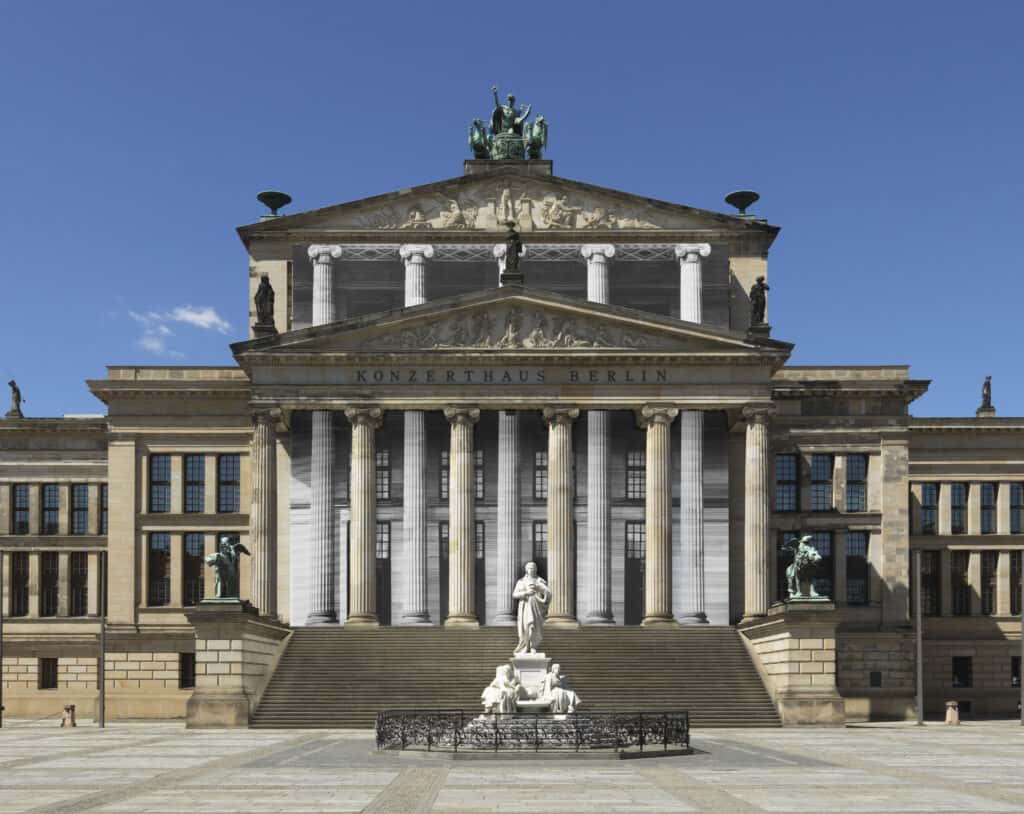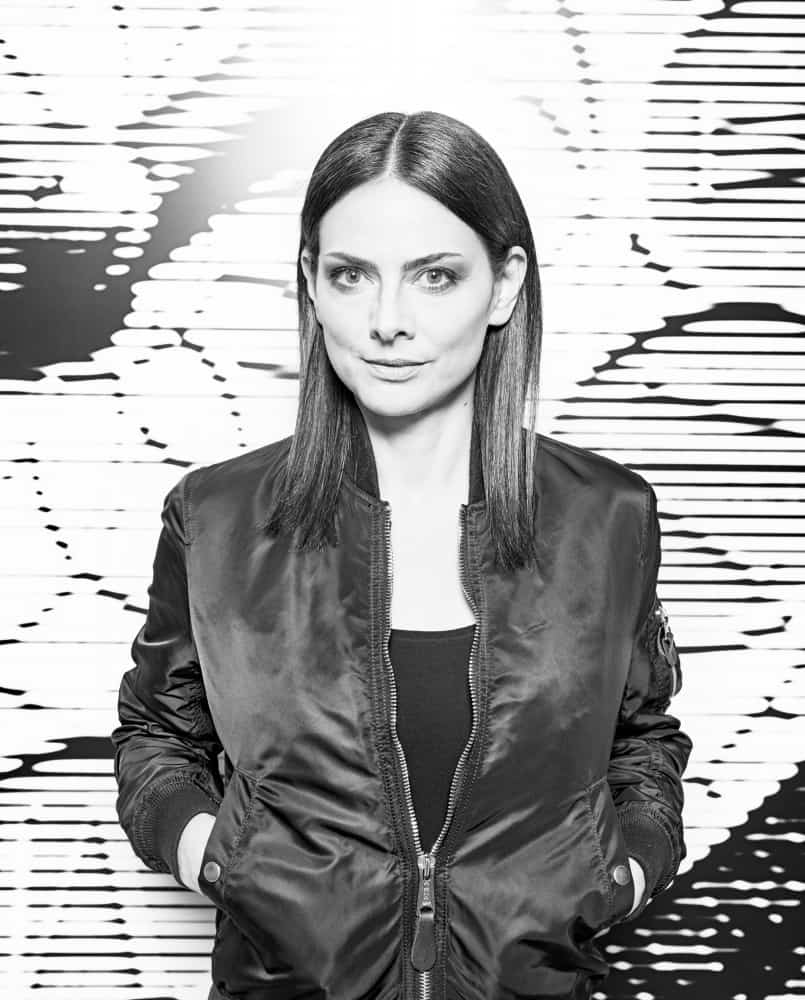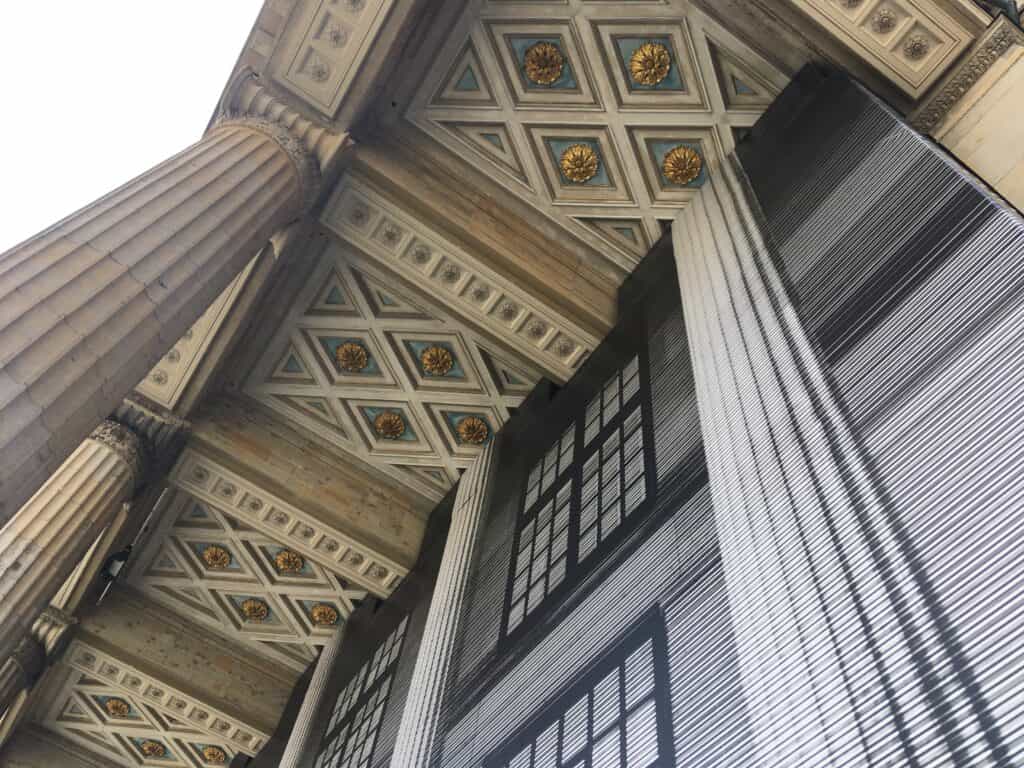Articles and Features
Bettina Pousttchi: Unveiling Amplifier, a Monumental Site-Specific Installation at Berlin’s Konzerthaus

By Shira Wolfe
“By altering the familiar dimensions, the installation changes the real perception of the building, creating a new experience of its own.”
Buchmann Galerie
Bettina Pousttchi
German artist Bettina Pousttchi is known for her large-scale, site-specific interventions into public space. Pousttchi predominantly works with sculpture and photography, and with her photographic works on building façades she seeks to challenge and expand the formal and conceptual possibilities of photography and sculpture while creating a dialogue with the urban space her works occupy.

Pousttchi first gained international attention in 2009 with her monumental photo installation Echo, which covered the façade of the Temporäre Kunsthalle at Berlin’s Schlossplatz. For this piece, she recreated Berlin’s Palace of the Republic (the building which hosted the parliament of the German Democratic Republic from 1976 to 1990, when Germany reunified) in the form of photographic wallpaper covering the four exterior walls of the Kunsthalle. This reimagining of the Palace of the Republic, which had been demolished between 2006-2008, was a bold statement and raised questions about the importance of history and memory in public space. The German parliament had decided to replace the Palace of the Republic with a simulation of the Prussian-style Berlin palace which had been built for Hohenzollern monarchs and demolished in the 1950s. To many Berliners, this move seemed to ignore the very particular history of post-war, divided Berlin, and by temporarily erecting the demolished Palace of the Republic on this site, Pousttchi brought these controversial decisions to the forefront of public consciousness.
Another extensive photo project is World Time Clock, a piece that reflects on the political and social organisation of time and space on a global level. For this piece, Pousttchi travelled to all 24 time zones, photographing public clocks in each one. The division of the world into time zones only took place at the end of the 19th century, and cannot be seen separately from the colonial powers that pushed for this uniform world time system to enforce adherence to their rigid structure. Time is power, and Pousttchi’s project reminds us of that in no uncertain terms. As such, her projects demand a focused re-viewing of the architectural, urban and social spaces that people generally tend to take for granted.
Konzerthaus Berlin
On the 26th of May 1821, Karl Friedrich Schinkel’s newly built design for the Königliches Schauspielhaus was unveiled at Berlin’s Gendarmenmarkt. Exactly 200 years later, on 26 May 2021, Konzerthaus Berlin celebrated its anniversary by unveiling the site-specific installation Amplifier Bettina Pousttchi on the main façade.
Initially a theatre, the Konzerthaus Berlin was greatly damaged in WWII and rebuilt as a concert hall in 1984, at the time still in the GDR. The reconstructed facade was completely historically accurate according to Schinkel’s original design, while the interior was redesigned to meet the needs of a concert hall, but still in keeping with Schinkel’s style.
“It perfectly reflects this illusion: What is real and what is not real?”
Sebastian Nordmann, Intendant, Konzerthaus Berlin

Amplifier, Bettina Pousttchi’s New Site-Specific Installation
The theme of the 2020/21 anniversary season at the Konzerthaus Berlin is “Nothing remains the same”. Due to the pandemic, Konzerthaus Berlin could no longer celebrate the anniversary as planned with indoor events and therefore decided to commission a work of art in the public space that could be enjoyed by everyone.
Given her strong background in site-specific work reflecting on the urban architecture and history of Berlin, Bettina Pousttchi was asked to create a new work of art interacting with the architecture of the Konzerthaus. The result is Amplifier, a large-scale photo installation created from photos the artist took of the Konzerthaus and assembled into a digital photomontage. Pousttchi explains that she was interested in applying the musical method of amplification to the realm of the visual arts, amplifying the original architecture with her large-scale installation. The black-and-white photo installation was mounted on the façade of the Konzerthaus, showing five columns in between the pre-existing six Ionic columns of the building. However, Pousttchi’s photographic columns extend beyond the first pediment and lead all the way up to the second pediment, thereby altering the known dimensions and changing the perception of the building. “It perfectly reflects this illusion: What is real and what is not real?” says Sebastian Nordmann, the Intendant of Konzerthaus Berlin.
Bettina Pousttchi will present new artworks at Buchmann Galerie in September 2021, as part of Berlin Art Week.